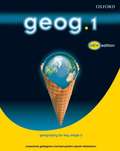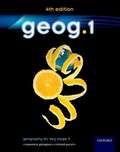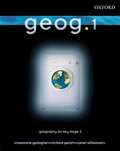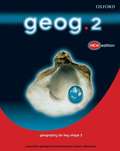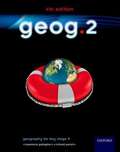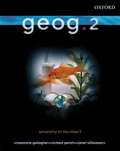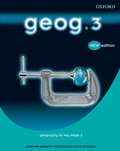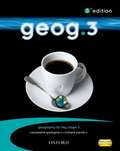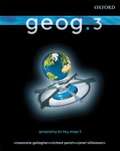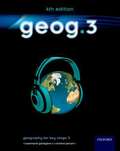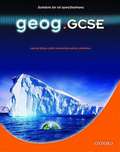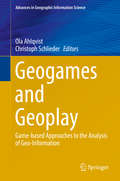- Table View
- List View
Geoforensics
by Alastair Ruffell Jennifer McKinleyThis book is a comprehensive introduction to the application of geoscience to criminal investigations. Clearly structured throughout, the text follows a path from the large-scale application of remote sensing, landforms and geophysics in the first half to the increasingly small-scale examination of rock and soils to trace amounts of material. The two scales of investigation are linked by geoscience applications to forensics that can be applied at a range of dimensions. These include the use of topographic mapping, x-ray imaging, geophysics and remote sensing in assessing whether sediment, rocks or concrete may have hidden or buried materials inside for example, drugs, weapons, bodies. This book describes the wider application of many different geoscience-based methods in assisting law enforcers with investigations such as international and national crimes of genocide and pollution, terrorism and domestic crime as well as accident investigation. The text makes a clear link to the increasingly important aspects of the spatial distribution of geoscience materials (be it soil sampling or the distribution of mud-spatter on clothing), Geographic Information Science and geostatistics. A comprehensive introduction to the application of geoscience to criminal investigation Examples taken from an environmental and humanitarian perspective in addition to the terrorist and domestic criminal cases more regularly discussed A chapter on the use of GIS in criminalistics and information on unusual applications and methods - for example underwater scene mapping and extraterrestrial applications Material on how geoscience methods and applications are used at a crime scene Accompanying website including key images and references to further material An invaluable text for both undergraduate and postgraduate students taking general forensic science degrees or geoscience courses "The whole book is peppered with useful and appropriate examples from the authors’ wide experiences and also from the wider literature... an essential purchase for any forensic science department as well as for any law enforcement organisation." Lorna Dawson, Macaulay Institute
Geoforming Mars: How could nature have made Mars more like Earth?
by Robert MalcuitThis book offers an exercise in theoretical planetology, presenting five different scenarios to assess the evolution of habitable conditions on Mars to assess planetary terraforming potential and to give insight into the ongoing search for habitable exoplanets. Four of the scenarios involve Martian satellite capture models, in which gravitational capture via tidal deformation and energy dissipation processes are measured to predict a pathway of biological evolution, while the fifth scenario analyzes the possible model that led to the Mars that we have today (i.e. with no life forms). In ten chapters, readers will learn how a Mars-like terrestrial planet can be transformed into a habitable planet, and what conditions must be assessed when searching for exoplanets in a star-centered orbit to support life. The book is intended for planetologists, and general enthusiasts of planetary evolution and our solar system.
Geog. 1: Student Book (2nd edition)
by Rosemarie Gallagher Janet Williamson Richard ParishGeog.1 is the first book in the three-book Geog.123 course written to match the National Curriculum at Key Stage 3 and the QCA Scheme of Work. It also provides excellent support for the Foundation Subjects strand of the National Strategy (FS/TLF), including starters and plenaries, levelled assessments, and help with implementing assessment for learning. The second editions of the students' books have been fully updated, and include particularly good coverage of topics such as Football (geog.1), Crime in the local community (geog.2), and the global fashion industry (geog.3). Many teachers have said that Geog.123 is the best course available. It is comprehensive and rigorous, but what really sets it apart is that it's written and presented in a way that appeals to students in the 11-14 age group like no other course.
Geog. 1: Student Book (2nd edition) (PDF)
by Rosemarie Gallagher Janet Williamson Richard ParishGeog.1 is the first book in the three-book Geog.123 course written to match the National Curriculum at Key Stage 3 and the QCA Scheme of Work. It also provides excellent support for the Foundation Subjects strand of the National Strategy (FS/TLF), including starters and plenaries, levelled assessments, and help with implementing assessment for learning. The second editions of the students' books have been fully updated, and include particularly good coverage of topics such as Football (geog.1), Crime in the local community (geog.2), and the global fashion industry (geog.3). Many teachers have said that Geog.123 is the best course available. It is comprehensive and rigorous, but what really sets it apart is that it's written and presented in a way that appeals to students in the 11-14 age group like no other course.
geog.1 Student Book 4th edition (PDF)
by Rosemarie Gallagher Richard Parishgeog. 123 is a three-book course for the National Curriculum at Grade 6-9. This 4th edition has been specially written to match the new Programme of Study (for teaching from 2014). geog. 123 combines a rigorous approach to content with a light touch, making it the most effective and engaging Grade 6-9 course available. Easy-to-use double-page spreads feature clearly-written objectives, student-friendly language, illustrated step-by-step explanations, up-to-date case studies and place-based examples, and high-quality photos, maps, and diagrams. Each Student Book has a glossary and full index. geog. 1 includes coverage of the geological timescale, mapskills, the UK, glaciation, rivers, and Africa. Each Student Book is supported by online lesson plans and presentations, online resources including animations, and worksheets, and online assessment materials; an online Student Book; a Teacher's Handbook; a Workbook; and a Workbook Answer Book.
Geog.123: Student's Book Level 1 (1st edition) (PDF)
by R. GallagherA rigorous approach to content with a lively presentation and style makes the book interesting, attractive and academically sound. Its features are: step-by-step illustrated explanations make new concepts very clear; the author's light touch will appeal to students and make the course interesting and engaging; very clear explanations will help the full ability range to grasp concepts; and fascinating facts and strange details make the book interesting for all students. Student activities can be answered from the text so give plenty of opportunities for understanding to be tested and for the full ability range to participate.
Geog. 2: Student Book (2nd edition) (PDF)
by Rosemarie Gallagher Richard ParishGeog.2 is the first book in the three-book Geog.123 course written to match the National Curriculum at Key Stage 3 and the QCA Scheme of Work. It also provides excellent support for the Foundation Subjects strand of the National Strategy (FS/TLF), including starters and plenaries, levelled assessments, and help with implementing assessment for learning. The second editions of the students' books have been fully updated, and include particularly good coverage of topics such as Football (geog.1), Crime in the local community (geog.2), and the global fashion industry (geog.3). Many teachers have said that Geog.123 is the best course available. It is comprehensive and rigorous, but what really sets it apart is that it's written and presented in a way that appeals to students in the 11-14 age group like no other course.
Geog.2: Geography for Key Stage 3 (PDF)
by Rosemarie Gallagher Richard Parishgeog.123 is a three-book course for the National Curriculum at Key Stage 3. This fourth edition has been specially written to match the new Programme of Study (for teaching from 2014). geog.2 includes coverage of GIS, population, urbanisation, weather and climate, coasts, Asia, and Southwest China. Features clearly-written objectives, student-friendly language, illustrated step-by-step explanations, up-to-date case studies and place-based examples, and high-quality photos, maps, and diagrams. Each Student Book has a glossary and full index. Contents include: Using GISnbsp; Population Urbanisation Coasts Weather and climate
Geog. 2: Student Book (1st edition) (PDF)
by Rosemarie Gallagher Janet Williamson Richard ParishGeog.2 is the second book in the three-book Geog.123 course written to match the National Curriculum at Key Stage 3 and the QCA Scheme of Work. It also provides excellent support for the Foundation Subjects strand of the National Strategy (FS/TLF), including starters and plenaries, levelled assessments, and help with implementing assessment for learning. Many teachers have said that Geog.123 is the best course available. It is comprehensive and rigorous, but what really sets it apart is that it's written and presented in a way that appeals to students in the 11-14 age group like no other course.
Geog. 2: Student Book (1st edition) (PDF)
by Rosemarie Gallagher Janet Williamson Richard ParishGeog.2 is the second book in the three-book Geog.123 course written to match the National Curriculum at Key Stage 3 and the QCA Scheme of Work. It also provides excellent support for the Foundation Subjects strand of the National Strategy (FS/TLF), including starters and plenaries, levelled assessments, and help with implementing assessment for learning. Many teachers have said that Geog.123 is the best course available. It is comprehensive and rigorous, but what really sets it apart is that it's written and presented in a way that appeals to students in the 11-14 age group like no other course.
Geog.2 (PDF) (400MB+)
by Rosemarie Gallagher Richard Parish400MB+ File Request - email bookshare@rnib.org.uk to request this title by WeTransfer. The students' book is revised and updated to deliver the revised Programme of Study for Key Stage 3 (from 2008). Contains direct, student-friendly language with illustrated step-by-step explanations.
geog.2 Student Book
by Richard Parish RoseMarie GallagherA new edition of geog.2 students' book, revised and updated to deliver both the Programme of Study for Geography at Key Stage 3 and new teaching and learning needs for greater preparation for GCSE. Contains direct, student-friendly language with illustrated step-by-step explanations.
Geog. 3: Student Book (2nd edition) (PDF)
by R. GallagherIMPORTANT: This PDF file is created from a non-text recognisable PDF and will contain some errors. The third in a three-book course, geog.3 is comprehensive and rigorous, but what really sets it apart is that it's written and presented in a way that appeals to students in the 11-14 age group like no other course. This is the second edition, from 2005.
Geog. 3: Student Book (3rd edition) (PDF)
by Rosemarie Gallagher Richard ParishThis new 2008 curriculum edition includes brand new chapters and is also packed full of the most up-to-the-minute topics such as the London Olympics and the 2007 floods. All this whilst retaining all the popular features teachers and students know and love.
Geog. 3
by Rosemarie Gallagher Richard Parishgeog.123 is a three-book course for the National Curriculum at Key Stage 3. This fifth edition matches the Programme of Study while meeting new teaching and learning needs for greater preparation for GCSE study. geog.123 combines a rigorous approach to content with a light touch, making it the most effective and engaging Key Stage 3 course available. Easy-to-use double-page spreads feature clearly-written objectives, student-friendly language, illustrated step-by-step explanations, up-to-date case studies and place-based examples, and high-quality photos, maps, and diagrams. Each students' book has a glossary and full index. geog.3 includes coverage of rocks, resources, economic activity, development, tectonics, Russia, and the Middle East. Each students' book is supported by online lesson plans and presentations, online resources including animations, videos, and worksheets, online assessment materials, an online student book, a teacher's handbook, and a workbook.
Geog. 3: Student Book (1st edition) (PDF)
by Rosemarie Gallagher Janet Williamson Richard ParishGeog.3 is the third book in the three-book Geog.123 course written to match the National Curriculum at Key Stage 3 and the QCA Scheme of Work. It also provides excellent support for the Foundation Subjects strand of the National Strategy (FS/TLF), including starters and plenaries, levelled assessments, and help with implementing assessment for learning. Many teachers have said that Geog.123 is the best course available. It is comprehensive and rigorous, but what really sets it apart is that it's written and presented in a way that appeals to students in the 11-14 age group like no other course.
Geog. 3: Student Book (1st edition)
by Rosemarie Gallagher Janet Williamson Richard ParishGeog.3 is the third book in the three-book Geog.123 course written to match the National Curriculum at Key Stage 3 and the QCA Scheme of Work. It also provides excellent support for the Foundation Subjects strand of the National Strategy (FS/TLF), including starters and plenaries, levelled assessments, and help with implementing assessment for learning. Many teachers have said that Geog.123 is the best course available. It is comprehensive and rigorous, but what really sets it apart is that it's written and presented in a way that appeals to students in the 11-14 age group like no other course.
Geog.3: Student Book (4th edition) (PDF)
by R. Rosemarie 1948-Gallaghergeog.123 is a three-book course for the National Curriculum at Key Stage 3. This 4th edition has been specially written to match the new Programme of Study. geog.3 includes coverage of international development, natural resources, economic activity, rocks, soils and weathering, earthquakes and volcanoes, Russia, and the Middle East.geog.123 combines a rigorous approach to content with a light touch, making it the most effective and engaging Key Stage 3 course available. Easy-to-use double-page spreads feature clearly-written objectives, student-friendly language, illustrated step-by-step explanations, up-to-date case studies and place-based examples, and high-quality photos, maps, and diagrams. Each Student Book has a glossary and full index.Each Student Book is supported by next generation Kerboodle, which features online lesson plans and presentations, online resources including animations, interactive activities, and differentiated worksheets, and online assessment materials; an online Kerboodle Book; a Teacher's Handbook; a Workbook; and a Workbook Answer Book.
Geog. GCSE: student book (PDF)
by John Edwards Chris Stevens Jack Mayhew Anna King Catherine HurtAn engaging students' book for GCSE Geography (14-16 years), providing up-to-date content and case studies. The course provides excellent support for the Secondary Strategy, including starters and plenaries and help with implementing assessment for learning. It is comprehensive and rigorous, and is written and presented in a way that appeals to students. Tectonic activity Rocks and landscapes Glacial landscapes River landscapes Coastal landscapes Weather and climate Ecosystems Population Settlement Agriculture Industry Managing resources Development
Geogames and Geoplay: Game-based Approaches to the Analysis of Geo-Information (Advances in Geographic Information Science)
by Ola Ahlqvist Christoph SchliederThis book brings together contributions from researchers, GIS professionals and game designers to provide a first overview of this highly interdisciplinary field. Its scope ranges from fundamentals about games and play, geographic information technologies, game design and culture, to current examples and forward looking analysis.Of interest to anyone interested in creating and using Geogames, this volume serves as a channel for sharing early experiences, discussing technological challenges and solutions, and outlines a future research agenda. Games and play are part of human life, and in many game activities, place, space and geography plays a central role in determining the rules and interactions that are characteristic of each game. Recent developments and widespread access to mobile information, communication, and geospatial technologies have spurred a flurry of developments, including many variations of gaming activities that are situated in, or otherwise connected to the real world.
Geographers: Biobibliographical Studies, Volume 20 (Geographers)
by Patrick H. Armstrong Geoffrey MartinAn annual collection of studies on major contributors to the development of geography and gepgraphical thought,
Geographers: Biobibliographical Studies, Volume 17 (Geographers)
by Patrick H. Armstrong Geoffrey MartinGeographers is an annual collection of studies on individuals who have made major contributions to the development of geography and geographical thought. Subjects are drawn from all periods and from all parts of the world, and include famous names as well as those less well known, including explorers, independent thinkers and scholars. Each paper describes the geographer's education, life and work and discusses their influence and spread of academic ideas. Each study includes a select bibliography and a brief chronology. The work includes a general index, and a cumulative index of geographers listed in volumes published to date. Published under the auspices of the International Geographical Union.
Geographers: Biobibliographical Studies, Volume 18 (Geographers)
by Patrick H. Armstrong Geoffrey MartinGeographers is an annual collection of studies on individuals who have made major contributions to the development of geography and geographical thought. Subjects are drawn from all periods and from all parts of the world, and include famous names as well as those less well known, including explorers, independent thinkers and scholars. Each paper describes the geographer's education, life and work and discusses their influence and spread of academic ideas. Each study includes a select bibliography and a brief chronology. The work includes a general index, and a cumulative index of geographers listed in volumes published to date.Published under the auspices of the International Geographical Union.
Geographers: Biobibliographical Studies, Volume 19 (Geographers)
by Patrick H. Armstrong Geoffrey MartinGeographers is an annual collection of studies on individuals who have made major contributions to the development of geography and geographical thought. Subjects are drawn from all periods and from all parts of the world, and include famous names as well as those less well known, including explorers, independent thinkers and scholars. Each paper describes the geographer's education, life and work and discusses their influence and spread of academic ideas. Each study includes a select bibliography and a brief chronology. The work includes a general index, and a cumulative index of geographers listed in volumes published to date.Published under the auspices of the International Geographical Union.


